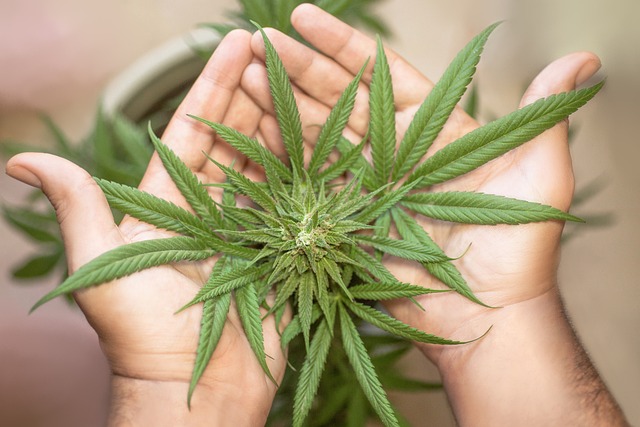The significance of THCA flower lab reports is crucial for users to accurately understand the effects and potential side effects associated with its consumption. These detailed reports provide precise information on the chemical composition, including THCA levels as well as other cannabinoids, terpenes, and contaminants present in the product. This data helps predict individual reactions and enables users to manage any adverse effects like anxiety or paranoia by dosing appropriately according to their tolerance levels. Moreover, lab reports ensure consumers are aware of a THCA flower's purity and potency, allowing for informed decision-making regarding its use. They also serve as a safeguard by alerting users to any harmful residual solvents or pesticides that could cause health issues or worsen side effects. In essence, these reports are invaluable tools for evaluating the risks and benefits of incorporating THCA flower into one's wellness routine, promoting a responsible and safe usage approach through scientific analysis and testing. It is imperative to consult Certificates of Analysis (COAs) from accredited labs when considering THCA flower products, as they offer critical insights into a product's composition, ensuring consumers can make educated choices based on the purity, potency, and safety of the THCA flower they purchase from reputable sources.
Exploring the multifaceted impact of THCA flower lab reports on consumer health, this article sheds light on the potential side effects associated with its use. Delving into the nuances of THCA’s chemical profile and safety considerations, we aim to empower readers with a clear understanding of how to interpret these pivotal documents. Our comprehensive analysis and navigational guide through THCA flower lab reports will equip you with the knowledge necessary to make informed decisions regarding its use.
- Understanding THCA Flower Lab Reports: A Comprehensive Analysis of Potential Side Effects
- Navigating THCA Flower Safety: Interpreting Lab Reports for Consumer Protection
Understanding THCA Flower Lab Reports: A Comprehensive Analysis of Potential Side Effects

When delving into the effects of THCA (Tetrahydrocannabinolic Acid) flower, it’s crucial to rely on thorough lab reports for a factual understanding of its potential side effects. These lab reports provide detailed chemical profiles, including the concentration of THCA and other cannabinoids, terpenes, and possible contaminants. Understanding the composition is key to anticipating how an individual may respond to its ingestion. THCA flower lab reports are instrumental in identifying any adverse reactions that users might experience, such as anxiety, paranoia, or discomfort at high dosages, which can be mitigated by proper dosing and individual tolerance considerations.
Furthermore, these reports offer insights into the purity and potency of the product, ensuring consumers make informed decisions about their use. They also highlight any detectable residual solvents or pesticides, which, if present, could elicit side effects or health concerns. By examining the THCA flower lab reports, users can better assess the risks and benefits associated with its consumption, leading to a more responsible and safe usage. It’s through this scientific analysis that consumers can make educated choices about incorporating THCA flower into their wellness regimen, while also being vigilant about any potential side effects reported by laboratory testing.
Navigating THCA Flower Safety: Interpreting Lab Reports for Consumer Protection

When engaging with THCA flower, a precursor to THC found in cannabis and hemp products, it is imperative to prioritize safety and quality assurance. Interpreting lab reports for THCA flower is a critical step in ensuring consumer protection. These reports offer detailed analyses of the product’s composition, including cannabinoid profiles, terpene content, and potential contaminants. For consumers, understanding the significance of these lab reports is vital; they serve as an objective measure of the product’s purity, potency, and safety.
Lab reports for THCA flower, often known as Certificates of Analysis (COAs), provide a comprehensive breakdown of the cannabinoid content. They detail the concentration of THCA, alongside other cannabinoids like CBD, CBN, and trace amounts that may be present. These reports also include a spectrum of terpenes, which contribute to the unique effects and flavors of the product. Additionally, they should indicate the absence of harmful contaminants such as pesticides, heavy metals, and residual solvents, all of which are paramount for consumer health and safety. By carefully reviewing these lab reports, consumers can make informed decisions about their THCA flower purchases, ensuring they receive a safe and effective product. It is advisable to purchase from reputable sources that provide up-to-date and transparent lab results for each batch of THCA flower.
When approaching THCA flower lab reports, it’s crucial to understand the potential side effects associated with its consumption. A thorough analysis of these lab reports offers valuable insights into ensuring safety and informed decision-making for consumers. The findings underscore the importance of attentive lab testing to safeguard health and promote responsible use of THCA flower. By equipping oneself with this knowledge, individuals can make educated choices that align with their well-being. It is through such diligent practices that we can navigate the complexities surrounding cannabinoid products responsibly.
